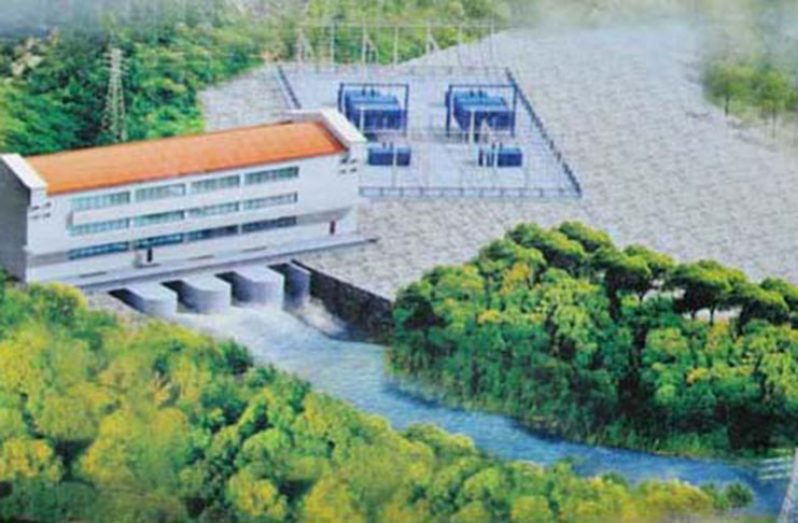IN keeping with its vision to accelerate Guyana’s transition to cleaner sources of energy, the government will be finalising plans for a second hydropower project between the years 2027-2030, while construction of the Amaila Falls project is set to commence this year.
Prime Minister Brigadier (ret’d) Mark Phillips, in his address to stakeholders at the International Energy Conference and Expo on Thursday said that a second project would have the potential to produce up to 165 Megawatts (MW) of energy, as will the the Amaila Falls Hydropower project.
The Amaila Falls project was sidelined by the former A Partnership for National Unity + Alliance For Change (APNU+AFC) government.
But, in late 2021, after being re-elected to office, the People’s Progressive Party/Civic (PPP/C) government granted its “no objection” for the Office of the Prime Minister to engage China Railway Group Limited to work on the hydropower project, based on a Build-Own-Operate-Transfer (BOOT) model.
The company will supply electricity to the Guyana Power and Light (GPL) Inc. at a cost not exceeding US$0.07737 per KWH, and provide the entire equity required by the project, and undertake all the risks associated with it.

Meanwhile, the Prime Minister, who has responsibility for the energy sector, said that several other projects will be undertaken across the country this year to cater to the growing energy needs of Guyanese.
Combined with other efforts, the Amaila Falls Hydropower project will lower the cost of electricity needed to fuel Guyana’s economic diversification and transformation into a low-carbon economy, as well as reduce the cost of power to businesses and households.
ENERGY INESTMENTS 2022
Aside from the major projects, the government has budgeted significant sums of money to undertake several energy-related projects in 2022.
Prime Minister Phillips said that those allocations are part of the government’s plan to transition to cleaner sources of energy, and reduce the country’s carbon footprint. In the 2022 budget, the government has allocated $29.4 billion to the energy sector.
The Prime Minister said that even with a major percentage of the country’s total population living on the coastland, the government is still investing heavily in hinterland electrification.
Several hinterland areas could expect to benefit significantly from the 2022 budget, as over $450 million has been budgeted for the expansion and upgrading of the hinterland electrification and power generation programme, through the purchase of generators and the expansion of distribution lines.
Prime Minister Phillips said that several projects are ongoing to improve energy access, and those include investments in solar photovoltaic (PV) systems in off-grid areas and the development of micro-grids for large hinterland areas.
Specifically, the projects entail the installation of 13 utility-scale solar farms; 30,000 solar home systems for hinterland riverine communities; 20 Solar PV grids for public buildings in the hinterland; over 180 PV stand-alone systems for government ICT hubs; and the installation of a three- megawatt grid connected solar PV system at the Cheddi Jagan International Airport.
The Prime Minister noted that those projects will result in approximately 46.4 megawatts installed solar PV capacity and are expected to be commissioned within the next two years.
Additionally, with the planned micro-hydropower systems, a total of 2.35 megawatts of power will be added to serve hinterland communities by 2024.
“Our government’s hinterland electrification programme aims to electrify some 200 unserved and underserved communities by 2026, using the most technical and economically feasible solutions that will include the advancement of the productive usages of energy,” the Prime Minister said.
Further, over $170 million has been budgeted for the completion of the 150 KW hydropower scheme at Kato.
$1.1 billion of the sector’s budget is earmarked for solar farm interventions in 2022. Those include the completion of the 1.5 MW solar farm at Bartica, 0.75 MW at Wakenaam, and the 1.0 MW at Lethem. It is also the government’s intention to tender for a 0.6 MW solar farm at Leguan and a 0.65 MW farm at Mahdia later this year.
In a bid to further reduce greenhouse gas emissions, the government will distribute and install over 22,000 LED bulbs and over 12,000 LED tubes in homes, businesses, and government buildings at Bartica, Linden, Leguan, and Wakenaam.
The initiative, which is anticipated to remove over 500 tonnes of carbon dioxide emissions from the environment, is part of the government’s plans to reduce the country’s carbon footprint.
Also this year, the government will pilot the installation of fast-charging stations for electric vehicles in Region Three (Essequibo Islands-West Demerara), Region Four (Demerara-Mahaica) and Region Six (East Berbice-Corentyne).




.png)









